Stuart Cummings Ripley was born on
March 3, 1892, in the small Ohio town of Cummings, founded
and named by his illustrious ancestors, not the least of
whom was the Reverend John C. Cummings, who was involved
with the Underground Railroad during the Civil War, and
who is mentioned twice in Harriet Beecher Stowe's Uncle
Tom's Cabin. The Reverend Cumming's home has been restored
and is maintained by the Ohio Historical Society. Except
for the local college, the Cummings home is the community's singular
attraction.
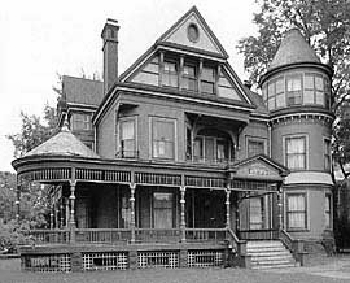 Ripley Ancestral Home (before restoration)
Ripley Ancestral Home (before restoration)At the time of Ripley's birth, Cummings was, and is, a farming
community, although Stuart's father, Horace John Ripley, practiced
law and was one of only two attorneys in the county. Stuart's
mother, Susannah Abigail Cummings, was a direct descendent
of the town's founders and a founding trustee of the local
college. One of young Stuart's proudest moments was winning his first-grade spelling bee during which he spelled correctly the word "antidisestablishmentarianism." Stuart attended the college for two years before
withdrawing, against his parents' wishes, to first work for
the local newspaper, and later as a foreign correspondent.
While Ripley's father was an amateur poet who encouraged
his son's literary interests, his mother was an aggressive
outdoorswoman, molding young Stuart into a self-reliant, sometimes
heroic, persona. The influences of each parent played a role
during Stuart's off and on career as a correspondent, most
notably in Mexico, the Middle East and Europe during World
War One, and the Spanish Civil War. Stuart's dispatches for
the leftist New Masses Journal in New York about the war in
Spain were instrumental in prompting Americans to enlist in
the anti-fascist Lincoln Brigade.
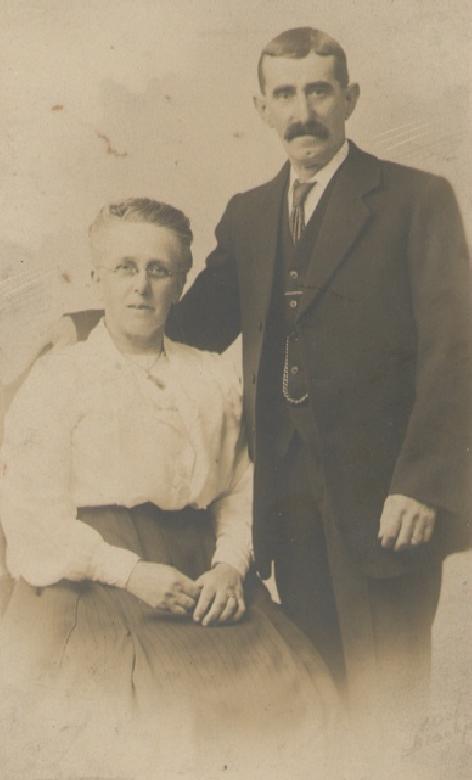 Ripley's mother and father, Horace and Susannah
Ripley's mother and father, Horace and SusannahAs a fledgling journalist for a far-left magazine, Ripley
covered General John Pershing's fruitless incursion into Mexico
in search of Pancho Villa. Three years later Ripley's eye-witness
experiences led to his first book, a fictional account of
the Battle of Carrizal, in which thirty-five Americans were
killed or captured by the Mexican Army. Later, Ripley claimed
he'd shot to death two Mexicans in order to escape. The novel,
Catastrophe at Carrizal (1919), went virtually unnoticed.
Edmund Wilson, in his collection of essays, The Triple
Thinkers (1938), while dismissing Catastrophe at Carrizal
as Ripley's fugitive work, also described him as "America's
greatest forgotten author."
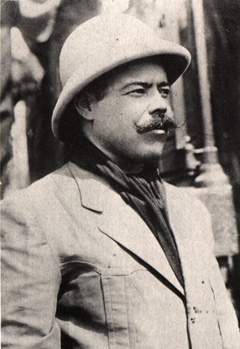 Pancho Villa
Pancho VillaIn 1917, Ripley went to Palestine to report on General Edmund
Allenby's capture of Jerusalem from the Turks, and where Ripley
became acquainted with T.E. Lawrence, the enigmatic British
warrior who often dressed in Arab garb and who was often called Lawrence of Arabia. It was said that Ripley
often rode with Lawrence, and that the two jointly abused
a homosexual Arab male reputed to have been a spy. Ripley's
experiences in the Holy Land led to three novels, now known
as the "Desert Triad."
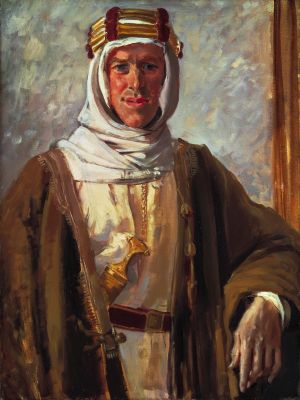 Lawrence of Arabia
Lawrence of Arabiahe following year, Ripley was in Europe
to cover the German siege of Paris. and after the armistice became part of
an
expatriate community that included Ernest Hemingway, Sherwood
Anderson, Djuna Barnes, Kay Boyle, John Dos Passos, F. Scott
Fitzgerald, Ford Madox Ford, H. D. (Hilda Doolittle), Henry
Miller, Ezra Pound, and
Gertrude Stein. It was rumored, although
he would neither confirm or deny it, that Ripley slept with
both H.D. and Dos Passos.
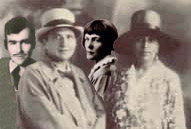 Young Ripley with Hilda Doolittle (H.D.), rear,
Young Ripley with Hilda Doolittle (H.D.), rear,
Gertrude Stein, Alice B. Toklas, ca. 1924
In Marseille, he met and romanced
the woman who would become his first wife,
Fleur Beauvais,
nineteen years old, and said to have been an upscale and exclusive prostitute. While their marriage was not to last, it inspired
Ripley's most significant book of poetry,
Fleur (1924). Although Ripley published a number of small, limited editions of his poetry,
Fleur was his most influential and erotic work.
 Fleur Beauvais
Fleur BeauvaisWeary of Europe, which he concluded was "decadent," his
marriage over and recovering from STD, Ripley returned to Ohio, only to find
the Midwestern experience stultifying, although it led to
one of his most important works, My Town (1928), which
focused on the hypocrisies of middleclass Americans.
Moving to a basement apartment on Jones Street in New York's
Greenwich Village, Ripley helped to launch a small but influential
monthly, Commonality. At the time, he was thought to have
been involved with the Communist Party, although it was never
established he was actually a member. He also met the woman
who would become his second wife, Sally Beacon, herself an
aspiring writer, poet, and admitted Communist Party member.
Their marriage produced one son, Thaddeus, who in turn provided
the couple with a grandson, Stuart Providence Ripley.
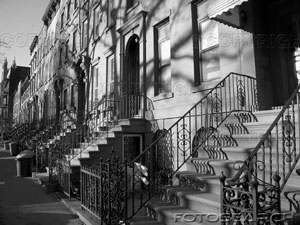 Ripley's brownstone, Greenwich Village, ca 1933
Ripley's brownstone, Greenwich Village, ca 1933The 1930s resulted in Ripley's most prodigious literary output.
Moving with Sally to a rented cottage in Sag Harbor, Long Island, he
published no fewer than four novels, two books of essays,
and a memoir about his expatriate days in Paris. None of the
books created interest, and Ripley's financial situation was
dire, saved only by the small inheritance he received following
the deaths of his parents and the sale of their home in Cummings,
Ohio. Ripley's connection with the photographer Walker Evans produced a notable nude portrait of Sally.
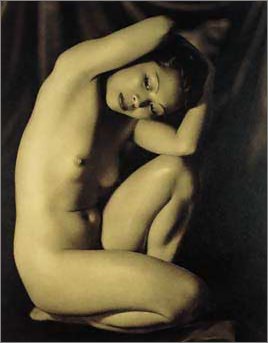 Sally Beacon, second wife, ca 1936
Sally Beacon, second wife, ca 1936
photo by Walker Evans Ripley, on assignment by the Ashtabula, Ohio, Star Beacon, covered the Spanish Civil War in the company of Ernest Hemingway, who introduced him to playwright Lillian Hellman, with whom it is believed Ripley had an affair. It was during this period that Ripley had a falling out with Hemingway, although the circumstances aren't completely clear. Ripley's association with the Lincoln Brigade captured the attention of right-wing communist witch hunters in the 1950s.
In 1939, Ripley's wife Sally committed suicide by drowning
in Long Island Sound. The tragedy resulted in a long period
of depression during which Ripley was unable to write. He
emerged from his depressed state only after the start of World
War Two, when he resumed his career as a foreign correspondent,
filing dispatches from both Europe and the Pacific for the
Hartford Courant. While not mentioned in any of his
reports, it's said that Ripley personally killed two Japanese
soldiers at Leyte. Ripley's best reportage was collected in
In Time of War (1946). After Hiroshima, Ripley went to Japan, where rumors circulated that he had a "relationship" with the woman known as Tokyo Rose, who was being held prisoner on war crimes charges.
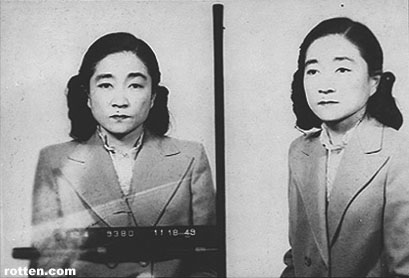 Tokyo Rose
Tokyo RoseLeaving Japan, Ripley returned to New York City to act as an English instructor at City College of New York. His
three stage plays, all produced off-Broadway by the East Side
Experimental Theatre Company, were well-received. He met a
young actress, Jill Castenberry, with whom he maintained an
intimate relationship for the rest of his life, although they
never married.
In 1952, Ripley was summoned by the House Un-American Activities
Committee to testify about his alleged links to the Communist
Party dating to the early 1930s. Ripley, denying he was a
party member, nevertheless named some of his associates of
the period, which produced enmity on the part of many of his
friends who accused him of betrayal. It also led to his dismissal
from CCNY. His screenplay of his 1938 novel Angel in the Clouds
was abruptly pulled without explanation. Dramatically, he
found himself more and more isolated.
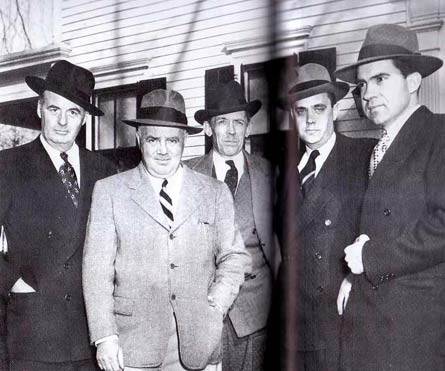 Ripley's disquinished inquisitors on the HUAC
Ripley's disquinished inquisitors on the HUACRipley and Castenberry moved to a small grape-growing farm
in Uhlerstown, Pennsylvania, a tiny community on the Delaware
River. Drinking and smoking heavily, and deeply depressed,
Ripley's literary output decreased, although it still included
two novels, unpublished in his lifetime, and an unfinished
biography of his mother. Unable to write, he turned to cooking
and became an accomplished amateur chef and vintner. His only
published book during this period, Recipes by Ripley,
was printed by the nearby Bethany Baptist-Methodist Church
as part of a fund-raising drive.
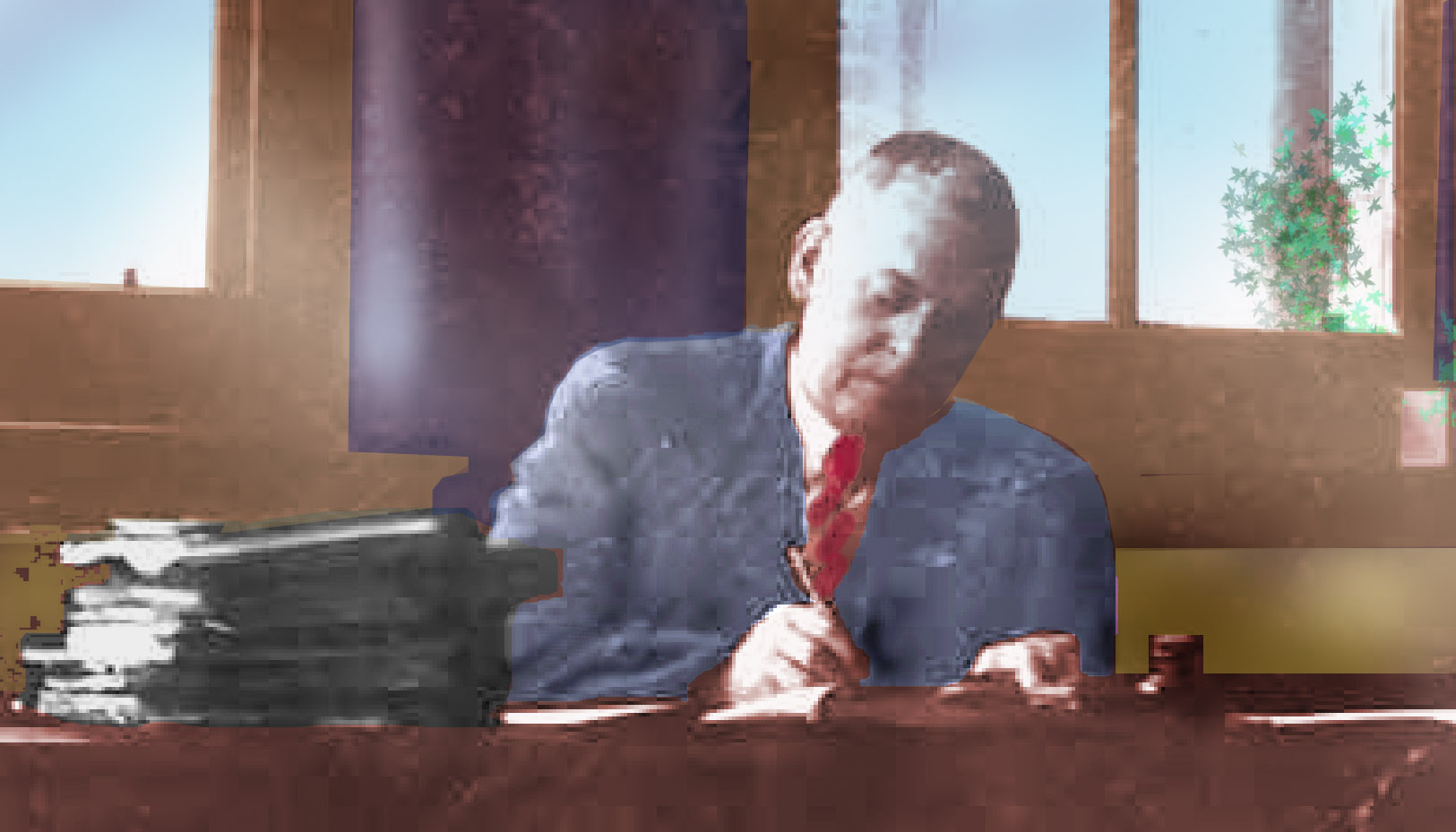 Ripley, Bucks County, 1964
Ripley, Bucks County, 1964A chain-smoker and heavy drinker, Ripley died in a Philadelphia hospital following a heart attack on February 2, 1964. He was seventy-two. He left no known will. Just prior to her death in 1988, Jill Castenberry donated Ripley's papers and manuscripts to Cummings College.

